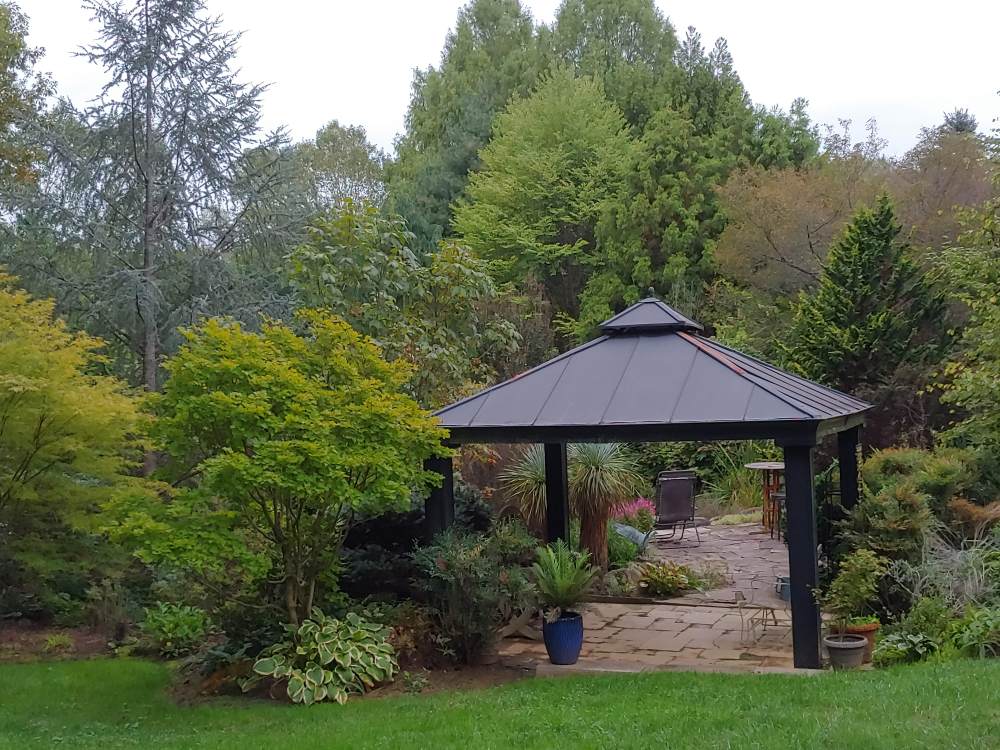There is always something to do in the garden, but twenty million things is perhaps a mild exaggeration. I admit there are times when the worklist grows long, with keeping up seeming hopeless, but by comparison there’s not a lot that must be done at the moment. Even in the busiest times I try to stay slow and steady, and a thing or two might be let go for longer than it should. Occasionally, I might not get around to something until it rots and goes away on its own, and that’s ideal. It’s the end result that counts, I tell my wife.

A limb from one of the tulip poplars that overhang the garden fell in a recent storm. It’s about as thick as my leg (and I have thick legs), and miraculously it missed everything except a few ferns that are soon to go dormant, so nothing worth talking about was damaged. It needs to be cut up and hauled off, but for now I just rolled it off the ferns. I’ll get to it soon, and then I’ll take a serious look at the nearby Alaskan cedar that is noticeably declining in too much shade. It’s not looking happy, but it’s thirty feet tall, in the middle, between an arbor and Japanese maples, and it’s underplanted with small treasures that are likely to be damaged when I’m stomping around (above), cutting the cedar up and trying not to destroy the neighboring garden.

If I have to bring someone in to help with the Alaskan cedar, there’s a dead oak about fifteen feet off the property line that has the right lean, and I’m afraid a clear path to fall onto the summerhouse by the koi pond (above). With luck, it might fall just short, but it looks ready to fall, with side branches dropping dangerously, and I shouldn’t leave it to chance. With help, I can cut the oak and direct it to fall harmlessly in the other direction. There’s no need to do anything but drop it, and let it rot. No one will know or care that it’s been dropped in this section of forest, but it’ll sure be a problem for me if it falls onto the summerhouse.
So, there are several projects that can kind of be rolled into one larger chainsaw project, and with the oak dead, that’s one less tree to drop leaves into the garden. But, there are plenty enough maples and tulip poplars to make deep piles a couple weeks from now. At some point, leaves must be raked or shredded so hellebores and other low growing plants aren’t buried. This is a multi day project, best done before leaves are wet and matted, but that would mean getting to it pretty soon after leaves fall. Usually, no, this doesn’t get done so quickly, and probably I’ll clear the hellebores and stone paths and leave the rest for later. Much later. On a pleasant day in February, that will be one thing on the worklist.
I know exactly what you mean. So much gardening, so little time to do it all! Still, your gardens look amazing!
My purpose in the garden is to be away from the other things I must do, so I try not to get bothered by anything except weeds that multiply if they’re not regularly managed. I haven’t done anything with the lawn in several years, so now there’s more clover than grass, which is not a big deal to me. I’m quite certain I have the worst lawn in the neighborhood, certainly the smallest with three quarters of the property planted. Some gardeners claim to enjoy every little chore, but I don’t and I’m perfectly happy to do nothing but plant and browse.
One thing I’ve learned over the years is that our gardens and yards quietly and slowly become something other than what we originally planned for them. I enjoy seeing the changes from year to year and try to disturb things as little as possible now. As for the lawn, I think the clover looks lovely in July!
your garden is really a spectacular treat! I haven’t commented since I’ve questioned you about your (my) Samaritan Dogwood as I’m in Chicago, but I do read all of your posts. I believe I follow you on Instagram, I’m hoping it’s you with the same screen name 🙂
I don’t knowingly have an Instagram page, but there are people in our company that do those things and I’m not always aware what they do with my stuff. In any case, I’m happy to have you visit.
Thirty feet sounds almost silly. We don’t have many trees that are less than thirty feet. We had some small locust trees removed, and they were more than eighty feet tall.
Our forests are a mix of tall maples and poplars, and dogwoods, redbuds and serviceberries that grow twenty to thirty feet tall.
That makes it even more odd, since we lack serviceberries, and most of our dogwoods and redbuds are less than twenty feet tall. The native dogwood is a low shrubby Cornus stolonifera.